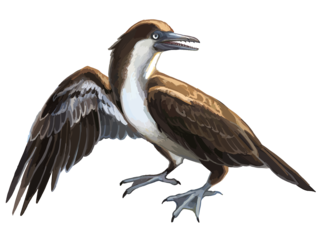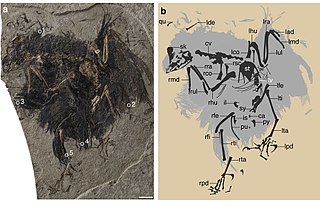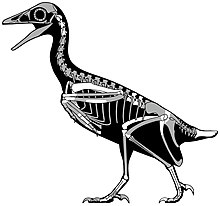
The Enantiornithes, also known as enantiornithines or enantiornitheans in literature, are a group of extinct avialans, the most abundant and diverse group known from the Mesozoic era. Almost all retained teeth and clawed fingers on each wing, but otherwise looked much like modern birds externally. Over eighty species of Enantiornithes have been named, but some names represent only single bones, so it is likely that not all are valid. The Enantiornithes became extinct at the Cretaceous–Paleogene boundary, along with Hesperornithes and all other non-avian dinosaurs.

Avisaurus is a genus of enantiornithine bird from the Late Cretaceous of North America.

Yanornis is an extinct genus of fish-eating Early Cretaceous birds. Two species have been described, both from Liaoning province, China: Yanornis martini, based on several fossils found in the 120-million-year-old Jiufotang Formation at Chaoyang, and Yanornis guozhangi, from the 124-million-year-old Yixian Formation.

Cretornis is a pterosaur genus from the late Cretaceous period of what is now the Jizera Formation in the Czech Republic, dating to about 92 million years ago. It only contains a single species, Cretornis hlavaci.
Elsornis is a genus of enantiornithine bird. Only one species is known, Elsornis keni. It lived during the Late Cretaceous. It is known from a partially articulated fossil skeleton found in the Gobi Desert in Mongolia.
Gurilynia is a genus of enantiornithine birds. One species is known, G. nessovi. It lived during the Maastrichtian stage of the Late Cretaceous period, between 70 and 66 mya. Gurilynia is known from fragmentary fossils found at the Gurilyn Tsav locality of the Nemegt Formation in south Gobi, Mongolia.

Yixianornis is a bird genus from the early Cretaceous period. Its remains have been found in the Jiufotang Formation at Chaoyang dated to the early Aptian age, around 120 million years ago. Only one species, Yixianornis grabaui, is known at present. The specific name, grabaui, is named after American paleontologist Amadeus William Grabau, who surveyed China in the early 20th century.

Avisauridae is a family of extinct enantiornithine dinosaurs from the Cretaceous period, distinguished by several features of their ankle bones. Depending on the definition used, Avisauridae is either a broad and widespread group of advanced enantiornithines, or a small family within that group, restricted to species from the Late Cretaceous of North and South America.

Kosmoceratops is a genus of ceratopsid dinosaur that lived in North America about 76–75.9 million years ago during the Late Cretaceous period. Specimens were discovered in Utah in the Kaiparowits Formation of the Grand Staircase–Escalante National Monument in 2006 and 2007, including an adult skull and postcranial skeleton and partial subadults. In 2010, the adult was made the holotype of the new genus and species Kosmoceratops richardsoni; the generic name means "ornate horned face", and the specific name honors Scott Richardson, who found the specimens. The find was part of a spate of ceratopsian discoveries in the early 21st century, and Kosmoceratops was considered significant due to its elaborate skull ornamentation.

Mystiornis is an extinct genus of bird which existed in what is now western Siberia, Russia during the early Cretaceous period. It is known from an isolated metatarsus found in the Shestakovo-1 locality of southern Western Siberia. It was named by Evgeny N. Kurochkin, Nikita V. Zelenkov, Alexandr O. Averianov and Sergei V. Leshchinskiy in 2011, and the type species is Mystiornis cyrili. While most recent studies place it as an Enantiornithine, specifically an Avisaurid, the authors note that the placement in both groups is tentative and further material will be required to make a firm decision on placement due to the unusual features of the existing material.

Teratophoneus is a genus of tyrannosaurine theropod dinosaur that lived during the late Campanian age of the Late Cretaceous period, in what is now Utah. It contains a single known species, T. curriei. It is known from an incomplete skull and postcranial skeleton recovered from the Kaiparowits Formation and was specifically named T. curriei in honor of famed paleontologist Philip J. Currie.
Elbretornis is an extinct genus of enantiornithine which existed in what is now Salta Province, Argentina during the late Cretaceous period.

Acristavus is a genus of saurolophine dinosaur. Fossils have been found from the Campanian Two Medicine Formation in Montana and Wahweap Formation in Utah, United States. The type species A. gagslarsoni was named in 2011. Unlike nearly all hadrosaurids except Edmontosaurus, Acristavus lacked ornamentation on its skull. The discovery of Acristavus is paleontologically significant because it supports the position that the ancestor of all hadrosaurids did not possess cranial ornamentation, and that ornamentation was an adaptation that later arose interdependently in the subfamilies Saurolophinae and Lambeosaurinae. It is closely related to Brachylophosaurus and Maiasaura, and was assigned to a new clade called Brachylophosaurini.

Nasutoceratops is an extinct genus of ceratopsian dinosaur. It is a basal centrosaurine which lived during the Late Cretaceous Period. Fossils have been found in southern Utah, United States. Nasutoceratops was a large, ground-dwelling, quadrupedal herbivore with a short snout and unique rounded horns above its eyes that have been likened to those of modern cattle. Extending almost to the tip of its snout, these horns are the longest of all the members of the centrosaurine subfamily. The presence of pneumatic elements in the nasal bones of Nasutoceratops are a unique trait and are unknown in any other ceratopsid.
Talos is an extinct genus of carnivorous bird-like theropod dinosaur, an advanced troodontid which lived during the late Cretaceous period in the geographic area that is now Utah, United States.

Tingmiatornis is a genus of flighted and possibly diving ornithurine bird from the High Arctic of Canada. The genus contains a single species, T. arctica, described in 2016, which lived during the Turonian epoch of the Cretaceous.

Cruralispennia is an extinct genus of enantiornithean bird. The only known specimen of Cruralispennia was discovered in the Early Cretaceous Huajiying Formation of China and formally described in 2017. The type species of Cruralispennia is Cruralispennia multidonta. The generic name is Latin for "shin feather", while the specific name means "many-toothed". The holotype of Cruralispennia is IVPP 21711, a semi-articulated partial skeleton surrounded by the remains of carbonized feathers.

Akainacephalus is a monospecific genus of ankylosaurid dinosaur from southern Utah that lived during the Late Cretaceous in what is now the Horse Mountain Gryposaur Quarry of the Kaiparowits Formation. The type and only species, Akainacephalus johnsoni, is known from the most complete ankylosaur specimen ever discovered from southern Laramidia, including a complete skull, tail club, a number of osteoderms, limb elements and part of its pelvis, among other remains. It was described in 2018 by Jelle P. Wiersma and Randall B. Irmis. It is closely related and shares similar cranial anatomy to Nodocephalosaurus.
Gettyia is an extinct genus of avisaurid enantiornithean bird from the Late Cretaceous of North America.
Yuanjiawaornis is an extinct genus of large enantiornithean bird known from the early Cretaceous of present-day China. It is monotypic, with only type species Y. virisosus known.


















